Alienation Coefficient and Wigner Distribution Function Based Protection Scheme for Hybrid Power System Network with Renewable Energy Penetration
Abstract
:1. Introduction
- An algorithm supported by the features of both voltage and current is introduced in this paper, which is effective to provide protection for the hybrid grid with RE penetration.
- A W-index is computed by processing the current signals using Wigner distribution function (WDF). Also an ALN-index is computed using sample-based alienation coefficients of voltage signals. Furthermore, fault index (FI) is computed from these W-index and ALN-index, which is effective for recognition of all the fault types incident on hybrid grid.
- The performance of the algorithm is not affected by the presence of high level of noise.
- The proposed algorithm is effective to provide high speed protection of hybrid grid. Faults were detected within a time less than th cycle.
- The algorithm is effective in discriminating switching transients from the faulty transients.
- The fault type was recognized using the number of faulty phases and identified using FI. A GFI, based on the processing of zero sequence currents using WDF is effective in differentiating the double phase (2P) and double phase to ground (2PG) faults.
- This algorithm works effectively and efficiently for the identification of faults on the hybrid grid during various operating scenarios such as fault location, various sampling frequencies, variations in the fault impedance, fault incidence angle and hybrid combination of the OH line and UG cable.
2. The Proposed Test System
2.1. Wind Energy Conversion System
2.2. Solar Photovoltaic System
3. The Proposed Algorithm for the Protection Scheme
3.1. Current Based Wigner Distribution Index
3.2. Voltage Based Alienation Index
3.3. Fault Index Based on Voltage and Current Features
3.4. Ground Fault Index
4. Faulty Event Recognition: Simulation Results
4.1. Impacts of Faulty Events on the Performance of Hybrid Grid and Requirement of Protection Schemes
4.2. Phase to Ground Fault
4.3. Double Phase Fault
4.4. Double Phase to Ground Fault
4.5. Three Phase to Ground Fault
5. Fault Classification
6. Implementation of the Algorithm to Recognize Faulty Events with Various Scenarios: Case Studies
6.1. Fault Location
6.1.1. Fault on Node 652
6.1.2. Fault on Node 634
6.2. Fault Impedance Variations
6.3. Fault Incidence Angle Variations
6.4. Effect of Noise
6.5. Sampling Frequency Variations
6.6. Recognition of Fault by Recording Voltage and Current Signals at PCC
7. Discrimination Between Switching and Faulty Events
7.1. Switching of Line Feeder
7.2. Capacitive Switching
7.3. Load Switching
8. Performance of Protection Scheme
8.1. Brief Discussion of Results
8.2. Comparative Study
9. Conclusions
Author Contributions
Funding
Conflicts of Interest
Abbreviations
| 2P | Double phase |
| 2PG | Double phase to ground |
| 3PG | Three phase to ground |
| PG | Phase to ground |
| ALN | Alienation |
| ANN | Artificial neural network |
| CB | Circuit breaker |
| DFIG | Doubly fed induction generator |
| DG | Distributed generation |
| DWT | Discrete Wavelet transform |
| ES | Expert system |
| EV | Electric vehicle |
| FI | Fault index |
| FIA | Fault incidence angle |
| FRDFT | Fast recursive discrete Fourier transform |
| FST | Fuzzy set theory |
| GFI | Ground fault index |
| ICT | Interconnecting transformer |
| IEEE | Institute of Electrical and Electronics Engineers |
| OH | Overhead |
| MATLAB | Matrix laboratory |
| MPPT | Maximum power point tracking |
| PCC | Point of common coupling |
| PQ | Power quality |
| PS | Protection scheme |
| PV | Photovoltaic |
| RE | Renewable energy |
| SF | Sampling frequency |
| SNR | Signal to noise ratio |
| ST | Stockwell transform |
| TM | Threshold magnitude |
| TMGFI | Threshold magnitude of ground fault index |
| UG | Underground |
| WECS | Wind energy conversion system |
| WD | Wigner distribution |
| WDF | Wigner distribution function |
References
- Aftab, M.A.; Hussain, S.S.; Ali, I.; Ustun, T.S. Dynamic protection of power systems with high penetration of renewables: A review of the traveling wave based fault location techniques. Int. J. Electr. Power Energy Syst. 2020, 114, 105410. [Google Scholar] [CrossRef]
- Eissa, M.; Awadalla, M.H. Centralized protection scheme for smart grid integrated with multiple renewable resources using Internet of Energy. Glob. Trans. 2019, 1, 50–60. [Google Scholar] [CrossRef]
- Fang, Y.; Jia, K.; Yang, Z.; Li, Y.; Bi, T. Impact of Inverter-Interfaced Renewable Energy Generators on Distance Protection and an Improved Scheme. IEEE Trans. Ind. Electron. 2019, 66, 7078–7088. [Google Scholar] [CrossRef]
- Barra, P.; Coury, D.; Fernandes, R. A survey on adaptive protection of microgrids and distribution systems with distributed generators. Renew. Sustain. Energy Rev. 2020, 118, 109524. [Google Scholar] [CrossRef]
- Eissa, M. Protection techniques with renewable resources and smart grids—A survey. Renew. Sustain. Energy Rev. 2015, 52, 1645–1667. [Google Scholar] [CrossRef]
- Alhelou, H.H.; Golshan, M.H.; Askari-Marnani, J. Robust sensor fault detection and isolation scheme for interconnected smart power systems in presence of RER and EVs using unknown input observer. Int. J. Electr. Power Energy Syst. 2018, 99, 682–694. [Google Scholar] [CrossRef]
- Kumar, D.S.; Srinivasan, D.; Reindl, T. A Fast and Scalable Protection Scheme for Distribution Networks With Distributed Generation. IEEE Trans. Power Deliv. 2016, 31, 67–75. [Google Scholar] [CrossRef]
- Pavlatos, C.; Vita, V.; Ekonomou, L. Syntactic pattern recognition of power system signals. In Proceedings of the 19th WSEAS International Conference on Systems (Part of CSCC’15), Zakynthos Island, Greece, 16–20 July 2015; pp. 16–20. [Google Scholar]
- Pavlatos, C.; Vita, V. Linguistic representation of power system signals. In Electricity Distribution; Springer: Berlin, Germany, 2016; pp. 285–295. [Google Scholar]
- Nieto, A.; Vita, V.; Maris, T.I. Power quality improvement in power grids with the integration of energy storage systems. Int. J. Eng. Res. Technol. 2016, 5, 438–443. [Google Scholar]
- Sheesh, R.O.; Amit, S.; Sunil, K.G.; Jhajharia, S.K.; Bhuvnesh, R.; Om Prakash, M. Wigner Distribution Function and Alienation Coefficient Based Transmission Line Protection Scheme. IET Gener. Transm. Distrib. 2020, 14, 1–12. [Google Scholar]
- Suman, T.; Mahela, O.P.; Ola, S.R. Detection of transmission line faults in the presence of wind power generation using discrete wavelet transform. In Proceedings of the 2016 IEEE 7th Power India International Conference (PIICON), Bikaner, India, 25–27 November 2016; pp. 1–6. [Google Scholar] [CrossRef]
- Suman, T.; Mahela, O.P.; Ola, S.R. Detection of transmission line faults in the presence of solar PV generation using discrete wavelet. In Proceedings of the 2016 IEEE 7th Power India International Conference (PIICON), Bikaner, India, 25–27 November 2016; pp. 1–6. [Google Scholar] [CrossRef]
- Thukral, S.; Mahela, O.P.; Kumar, B. Detection of transmission line faults in the presence of solar PV system using stockwell’s transform. In Proceedings of the 2016 2016 IEEE 7th Power India International Conference (PIICON), Bikaner, India, 25–27 November 2016; pp. 1–6. [Google Scholar] [CrossRef]
- Ola, S.; Saraswat, A.; Goyal, S.; Jhajharia, S.; Mahela, O.P. Detection and Analysis of Power System Faults in the Presence of Wind Power Generation Using Stockwell Transform Based Median. In Intelligent Computing Techniques for Smart Energy Systems; Lecture Notes in Electrical Engineering; Kalam, A., Niazi, K., Soni, A., Siddiqui, S., Mundra, A., Eds.; Springer: Singapore, 2020; Volume 607, pp. 319–330. [Google Scholar] [CrossRef]
- Kersting, W.H. Radial distribution test feeders. Power Syst. IEEE Trans. 1991, 6, 975–985. [Google Scholar] [CrossRef]
- Kersting, W. Radial distribution test feeders. In Proceedings of the Power Engineering Society Winter Meeting, Columbus, OH, USA, 1 February 2001; Volume 2, pp. 908–912. [Google Scholar] [CrossRef]
- Mahela, O.P.; Shaik, A.G. Power quality improvement in distribution network using {DSTATCOM} with battery energy storage system. Int. J. Electr. Power Energy Syst. 2016, 83, 229–240. [Google Scholar] [CrossRef]
- Paz, M.C.R.; Ferraz, R.G.; Bretas, A.S.; Leborgne, R.C. System unbalance and fault impedance effect on faulted distribution networks. Comput. Math. Appl. 2010, 60, 1105–1114. [Google Scholar] [CrossRef] [Green Version]
- Shaik, A.G.; Mahela, O.P. Power quality assessment and event detection in hybrid power system. Electric Power Syst. Res. 2018, 161, 26–44. [Google Scholar] [CrossRef]
- Mahela, O.P.; Shaik, A.G. Power Quality Detection in Distribution System with Wind Energy Penetration Using Discrete Wavelet Transform. In Proceedings of the 2015 Second International Conference on Advances in Computing and Communication Engineering (ICACCE), Dehradun, India, 1–2 May 2015; pp. 328–333. [Google Scholar] [CrossRef]
- Mahela, O.P.; Khan, B.; Alhelou, H.H.; Siano, P. Power Quality Assessment and Event Detection in Distribution Network with Wind Energy Penetration Using Stockwell Transform and Fuzzy Clustering. IEEE Trans. Ind. Inform. 2020, 1–10, in press. [Google Scholar] [CrossRef]
- Kuo, C.L.; Lin, C.H.; Yau, H.T.; Chen, J.L. Using Self-Synchronization Error Dynamics Formulation Based Controller for Maximum Photovoltaic Power Tracking in Micro-Grid Systems. Emerg. Sel. Top. Circ. Syst. IEEE J. 2013, 3, 459–467. [Google Scholar] [CrossRef]
- Ding, K.; Bian, X.; Liu, H.; Peng, T. A MATLAB-Simulink-Based PV Module Model and Its Application Under Conditions of Nonuniform Irradiance. Energy Convers. IEEE Trans. 2012, 27, 864–872. [Google Scholar] [CrossRef]
- Mahela, O.P.; Shaik, A.G. Power quality recognition in distribution system with solar energy penetration using S-transform and Fuzzy C-means clustering. Renew. Energy 2017, 106, 37–51. [Google Scholar] [CrossRef]
- Khan, N.A.; Taj, I.A.; Jaffri, M.N.; Ijaz, S. Cross-term elimination in Wigner distribution based on 2D signal processing techniques. Signal Process. 2011, 91, 590–599. [Google Scholar] [CrossRef]
- Cheng, J.Y.; Huang, S.J.; Hsieh, C.T. Application of Gabor–Wigner transform to inspect high-impedance fault-generated signals. Int. J. Electr. Power Energy Syst. 2015, 73, 192–199. [Google Scholar] [CrossRef]
- Rathore, B. Alienation based fault detection and classification in transmission lines. In Proceedings of the 2015 Annual IEEE India Conference (INDICON), New Delhi, India, 17–20 December 2015; pp. 1–6. [Google Scholar] [CrossRef]
- Rathore, B.; Shaik, A.G. Wavelet-alienation based protection scheme for multi-terminal transmission line. Electric Power Syst. Res. 2018, 161, 8–16. [Google Scholar] [CrossRef]


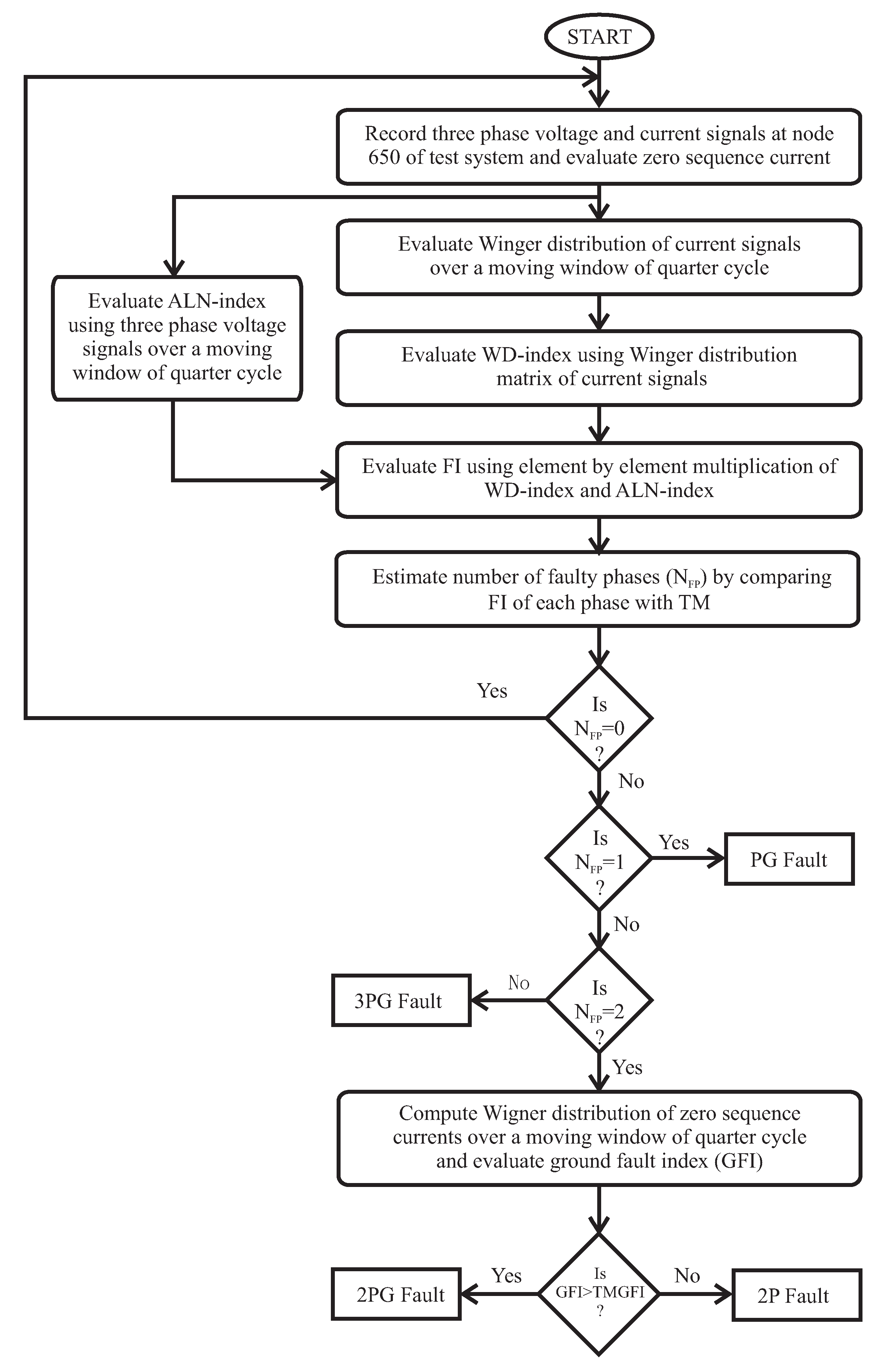

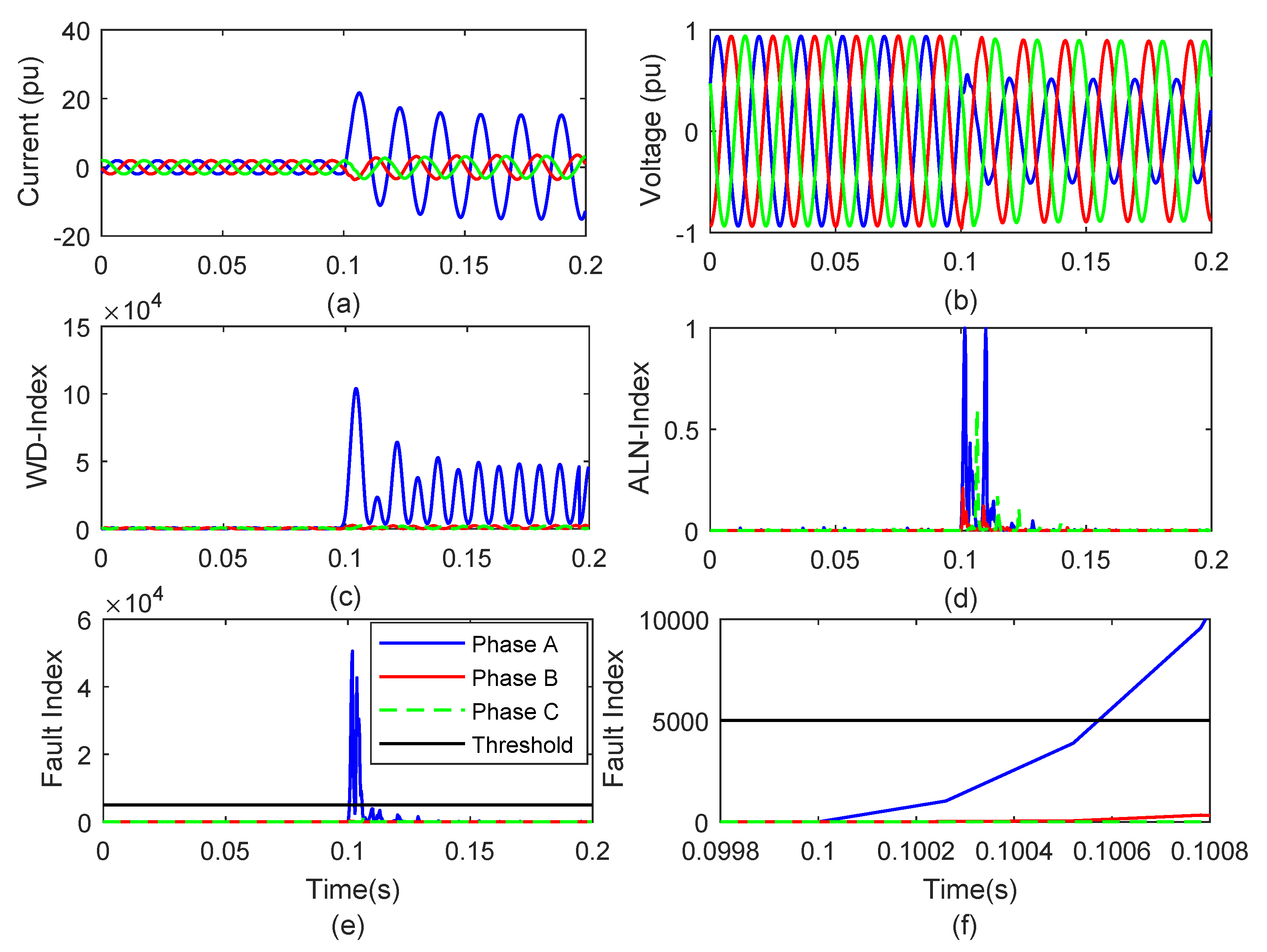
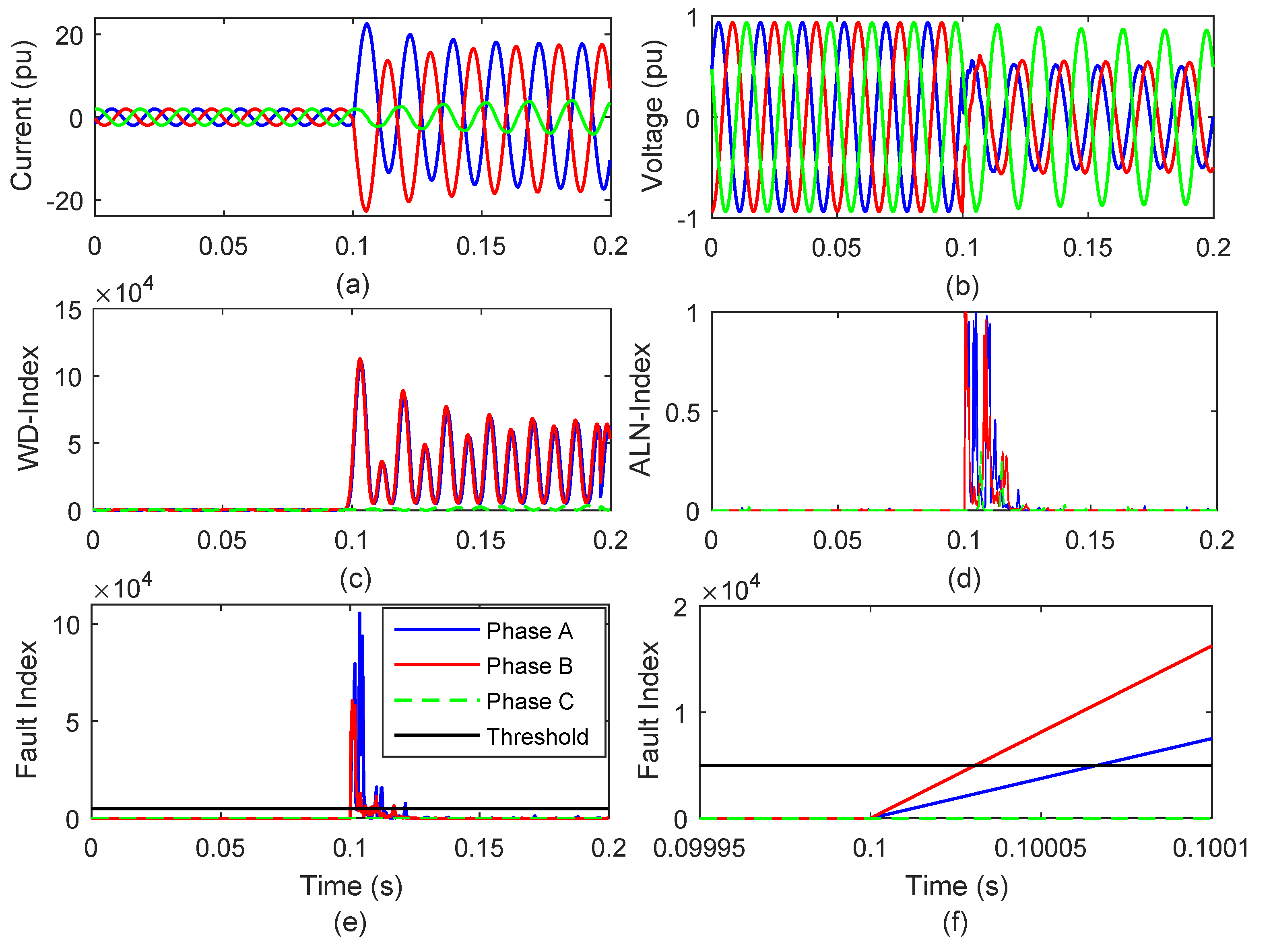

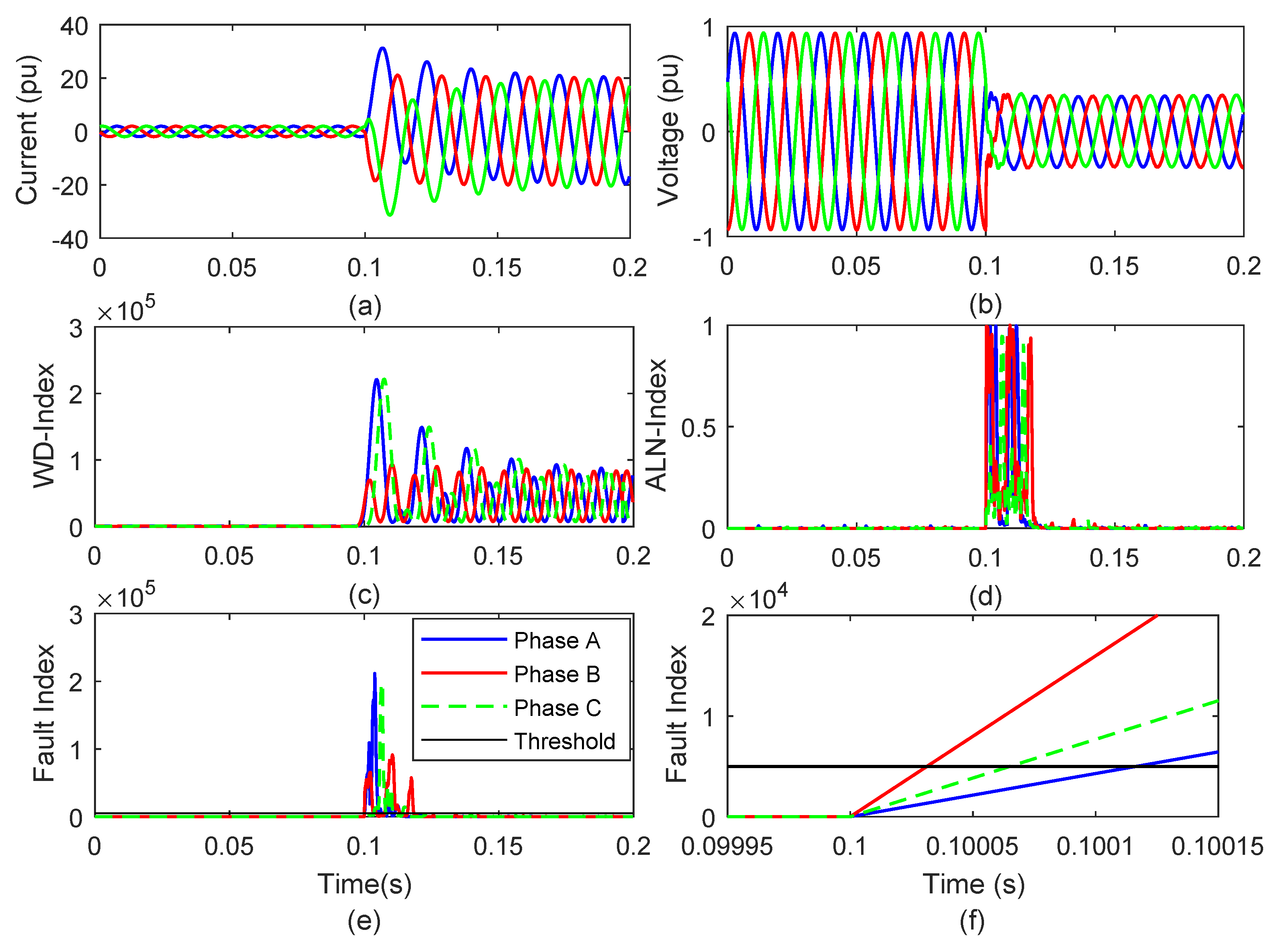
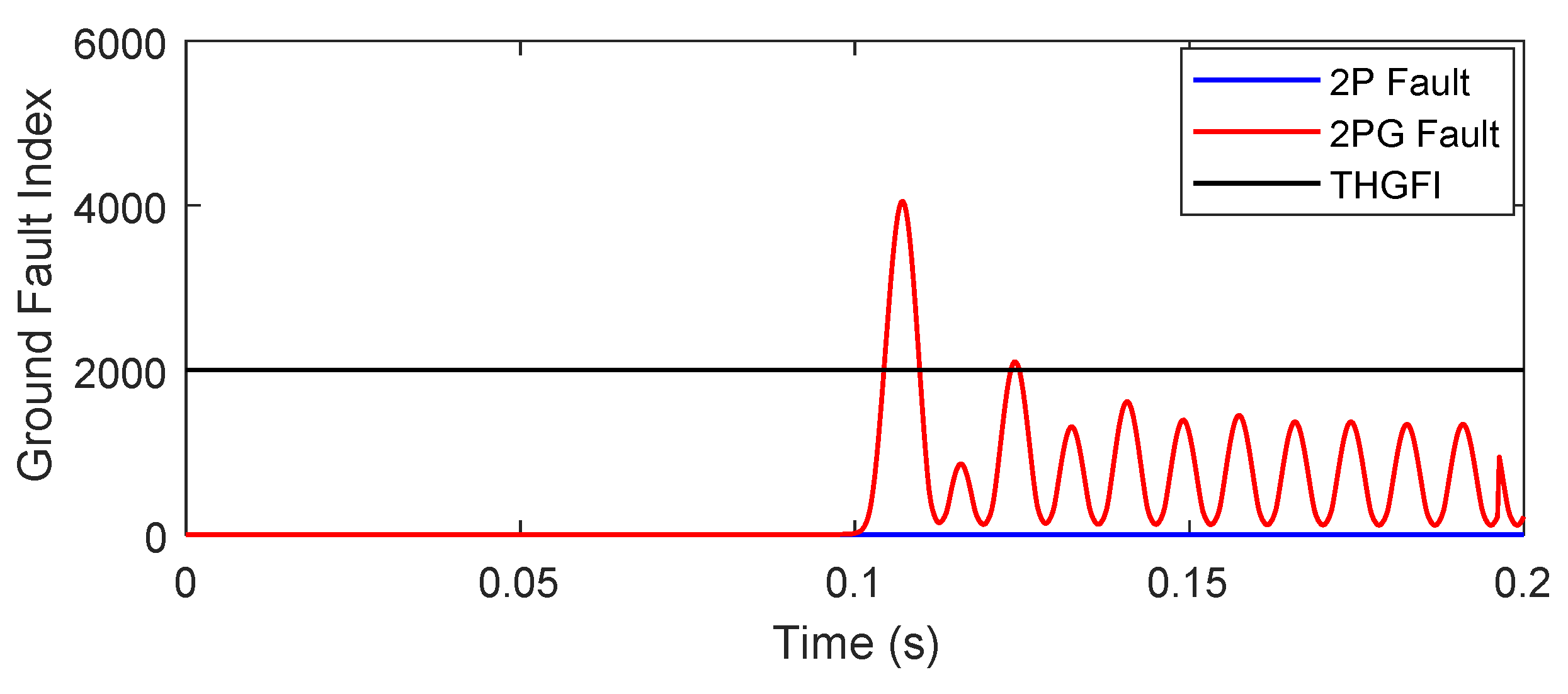

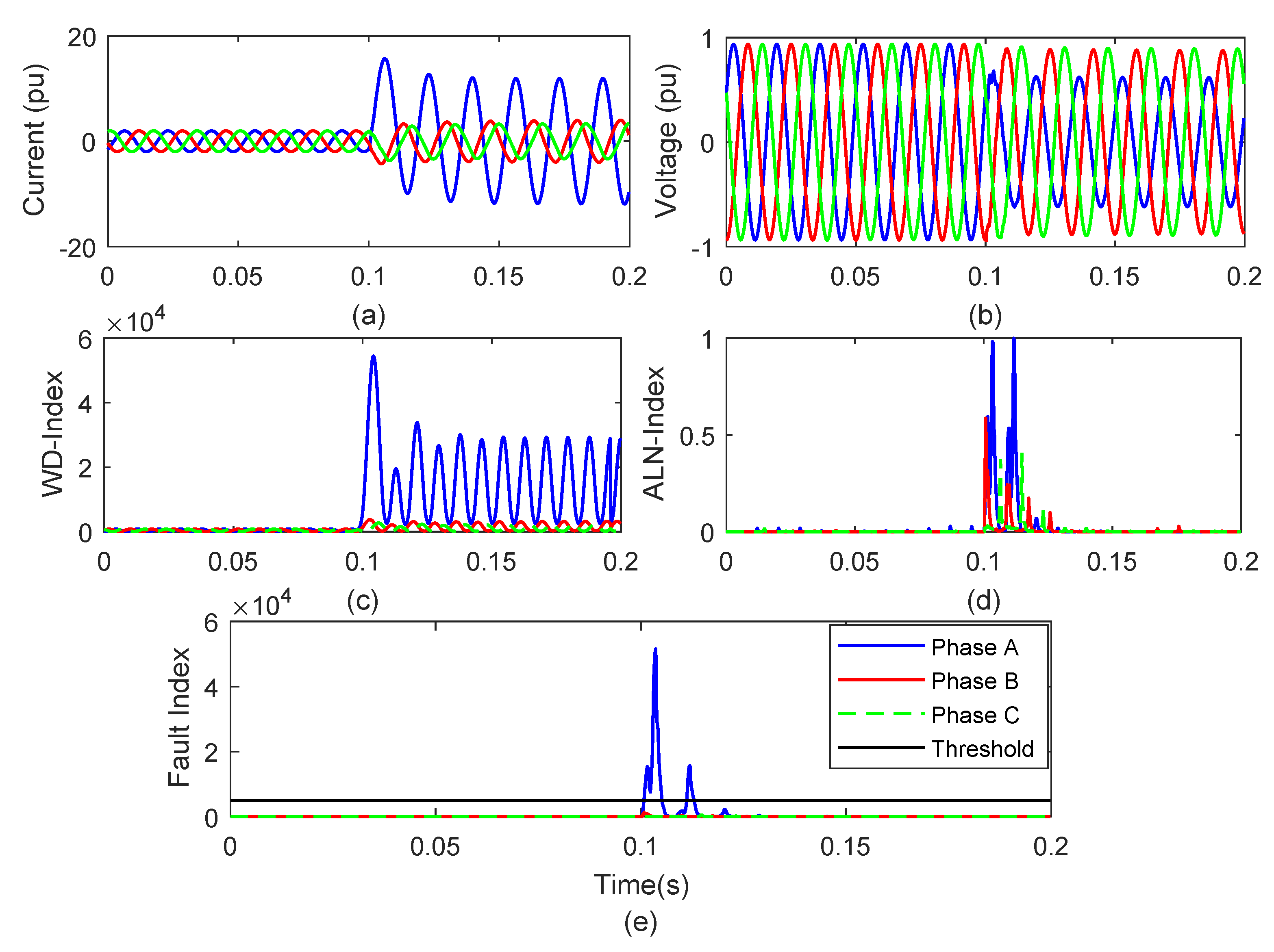

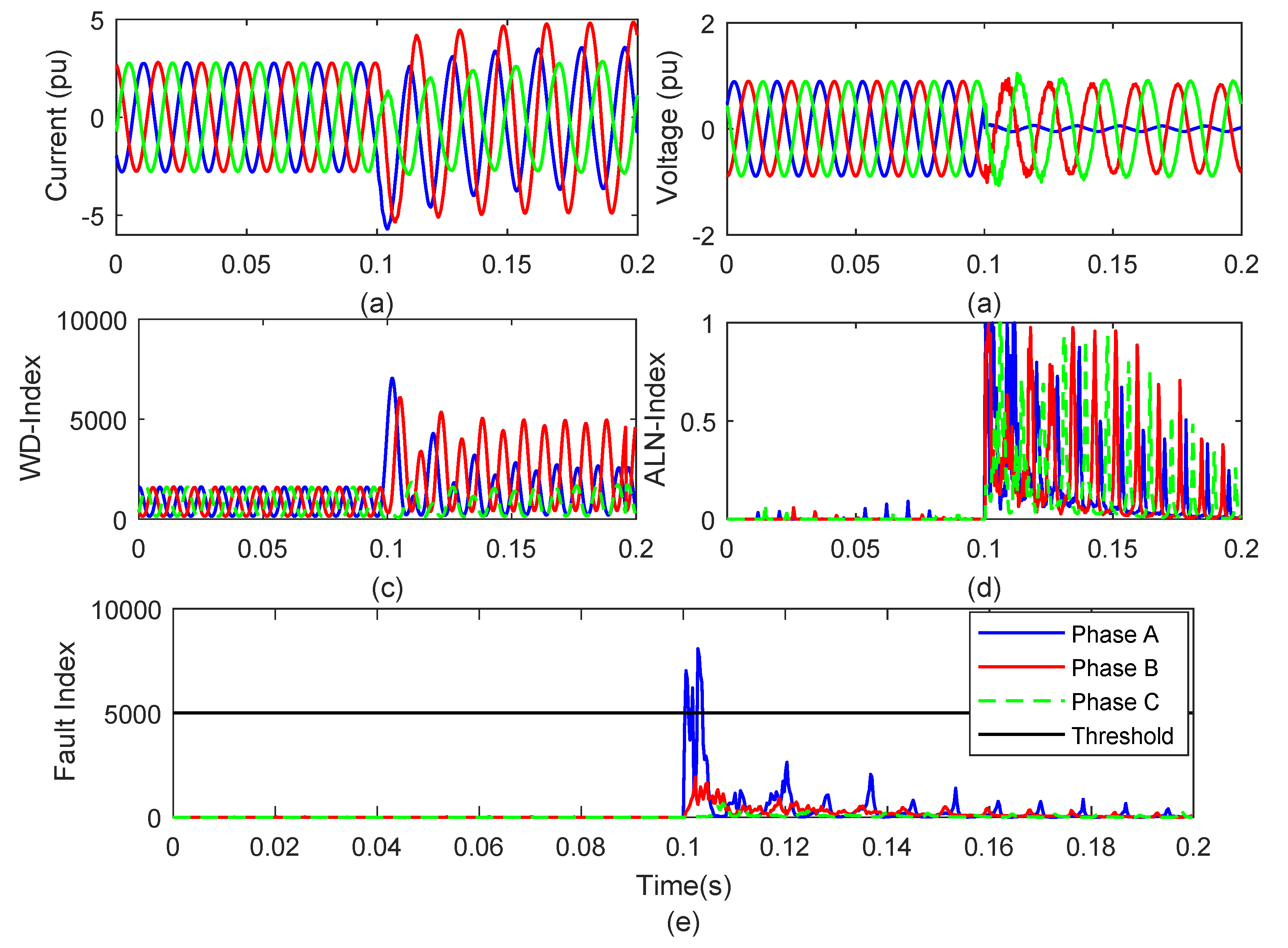
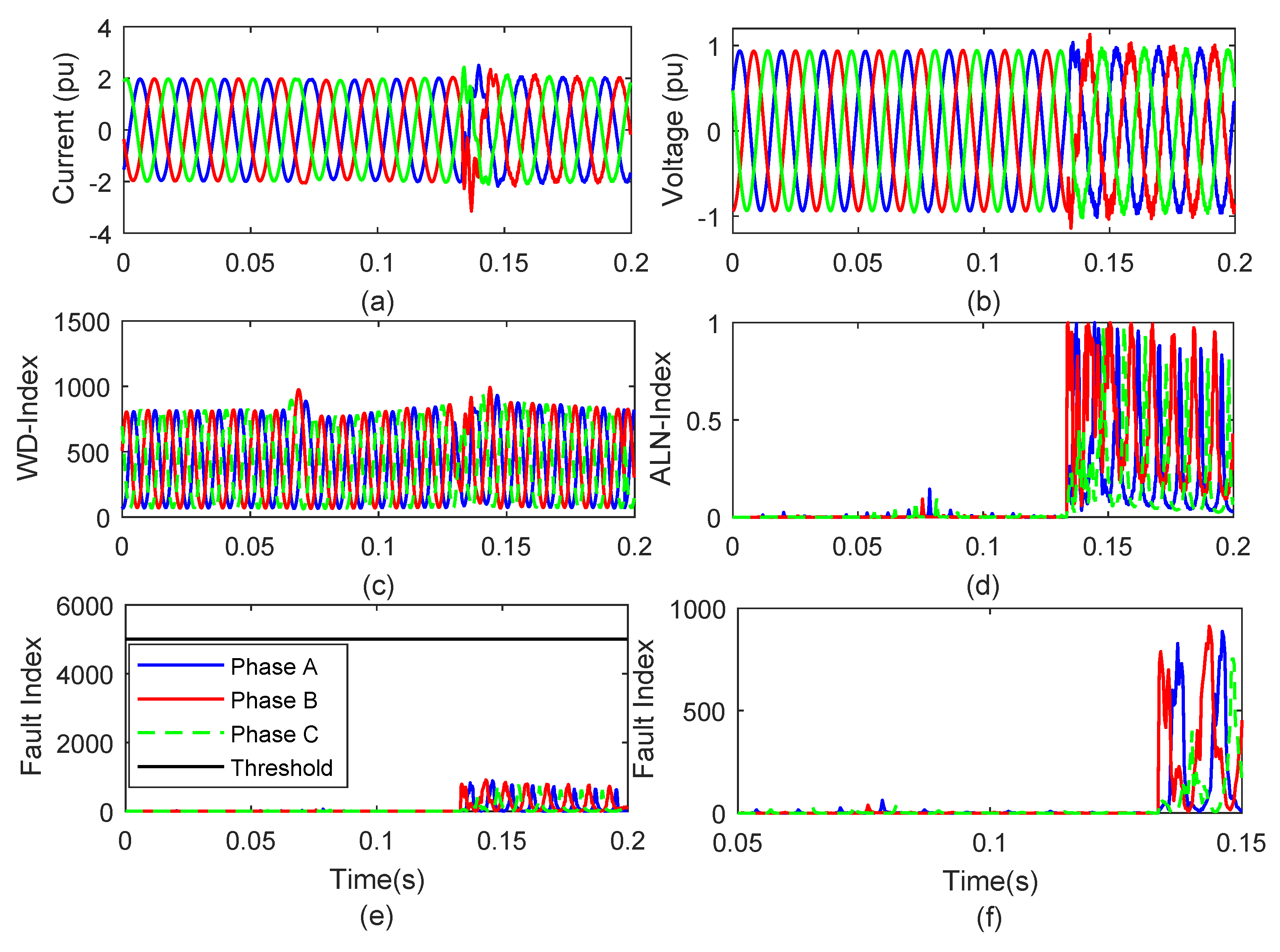
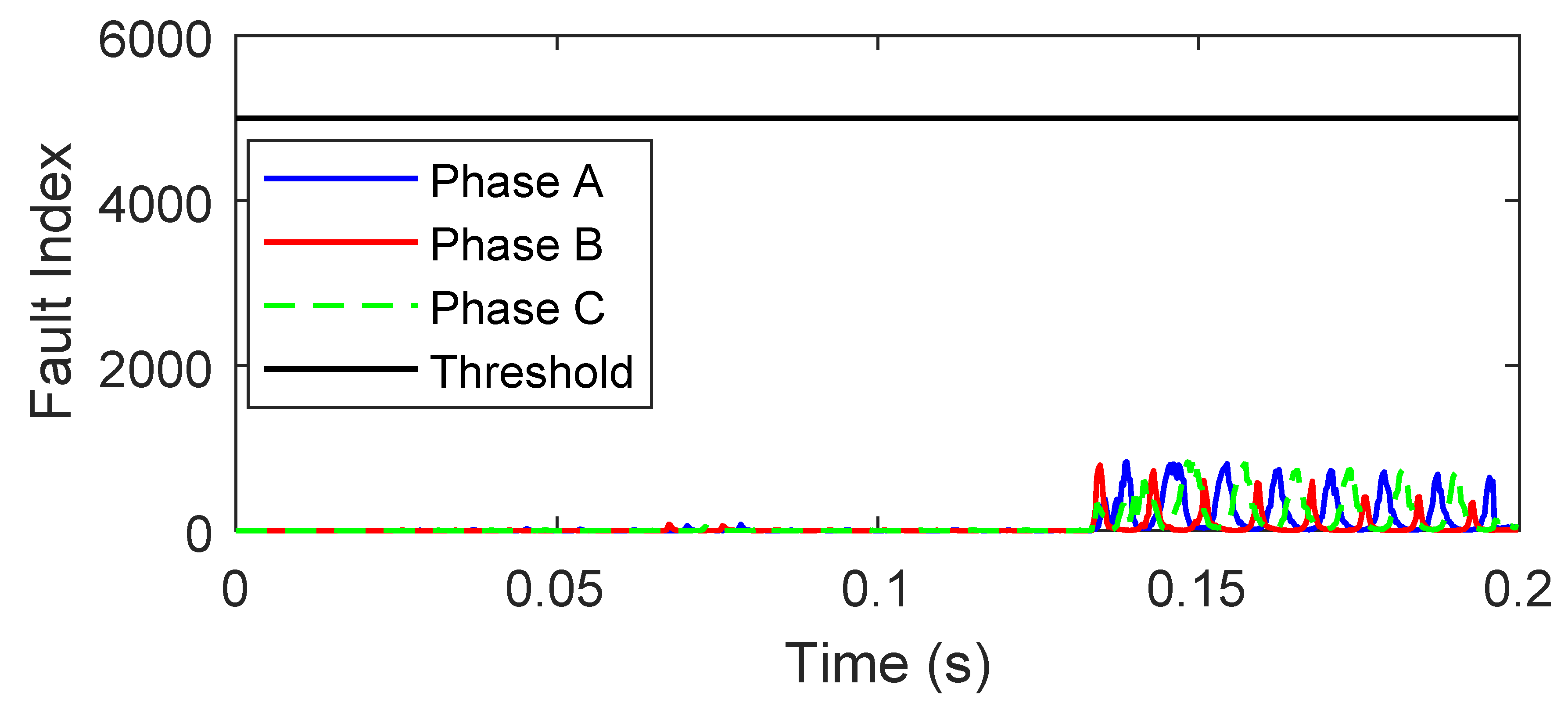
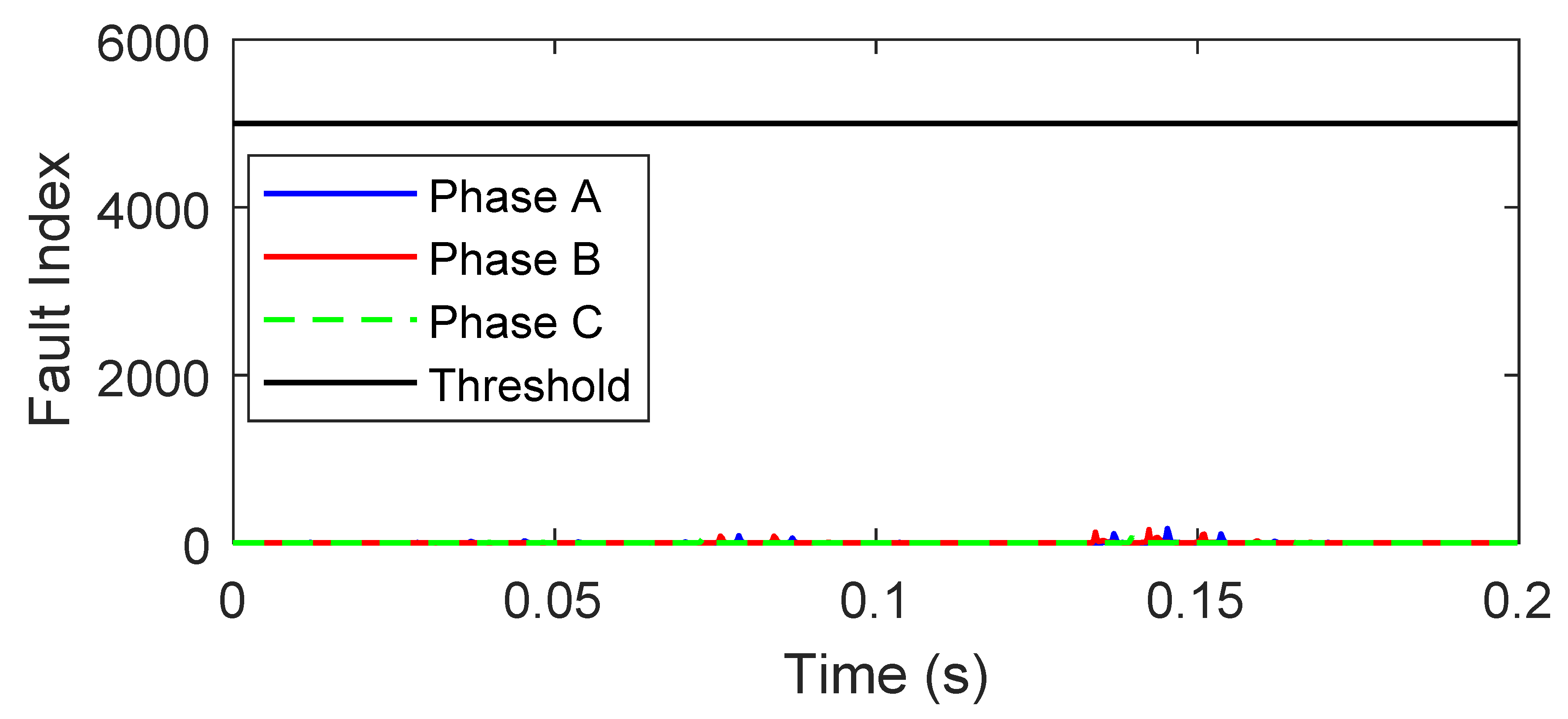
| Node A | Node B | Length of Feeder (m) | Configuration of Feeder |
|---|---|---|---|
| 632 | 645 | 152.40 | 601 |
| 632 | 633 | 152.40 | 601 |
| 633 | 634 | 0 | XFM |
| 645 | 646 | 91.440 | 601 |
| 650 | 632 | 609.60 | 601 |
| 684 | 652 | 243.84 | 606 |
| 632 | 671 | 609.60 | 601 |
| 671 | 684 | 680.00 | 601 |
| 671 | 692 | 0 | Switch |
| 684 | 611 | 91.44 | 601 |
| 692 | 675 | 152.40 | 606 |
| Nodes | Load Model | Load | Capacitor Banks | |
|---|---|---|---|---|
| kW | kVAr | (kVAr) | ||
| 634 | Y-PQ | 400 | 290 | |
| 645 | Y-PQ | 170 | 125 | |
| 646 | Y-PQ | 230 | 132 | |
| 652 | Y-PQ | 128 | 86 | |
| 671 | Y-PQ | 1155 | 660 | |
| 675 | Y-PQ | 843 | 462 | 600 |
| 692 | Y-PQ | 170 | 151 | |
| 611 | Y-PQ | 170 | 80 | 100 |
| 632–671 | Y-PQ | 200 | 116 | |
| Transformer | MVA | kV | kV | HV Winding | LV Winding | ||
|---|---|---|---|---|---|---|---|
| High | Low | R | X | R | X | ||
| TRFG | 10 | 115 | 4.16 | 29.095 | 211.60 | 0.1142 | 0.8306 |
| TRFF | 5 | 4.16 | 0.48 | 0.3807 | 2.7688 | 0.0510 | 0.0042 |
| TRFS | 1 | 4.16 | 0.260 | 0.1730 | 195.70 | 0.0007 | 0.7645 |
| TRFW | 5 | 4.16 | 0.48 | 0.3807 | 2.7688 | 0.0510 | 0.0042 |
| Test Node | Fault Index Magnitude | ||
|---|---|---|---|
| Phase-A | Phase-B | Phase-C | |
| 646 | 332 | 1370 | |
| 632 | 645 | 1855 | |
| 634 | 348 | 998 | |
| 652 | 1170 | 439 | |
| 611 | 1491 | 1785 | |
| 671 | 2711 | 2886 | |
| 675 | 1529 | 2001 | |
| Phase Name | Fault Index Magnitude | |||||
|---|---|---|---|---|---|---|
| Phase-A | 8252 | |||||
| Phase-B | 332 | 317 | 284 | 253 | 232 | 199 |
| Phase-C | 1370 | 1101 | 923 | 457 | 333 | 316 |
| Phase Name | Fault Index Magnitude | |||||
|---|---|---|---|---|---|---|
| 0 | 30 | 60 | 90 | 120 | 150 | |
| Phase-A | ||||||
| Phase-B | 332 | 1107 | 621 | 1323 | 1146 | 704 |
| Phase-C | 1370 | 1244 | 985 | 1327 | 156 | 75 |
© 2020 by the authors. Licensee MDPI, Basel, Switzerland. This article is an open access article distributed under the terms and conditions of the Creative Commons Attribution (CC BY) license (http://creativecommons.org/licenses/by/4.0/).
Share and Cite
Ram Ola, S.; Saraswat, A.; Goyal, S.K.; Sharma, V.; Khan, B.; Mahela, O.P.; Haes Alhelou, H.; Siano, P. Alienation Coefficient and Wigner Distribution Function Based Protection Scheme for Hybrid Power System Network with Renewable Energy Penetration. Energies 2020, 13, 1120. https://doi.org/10.3390/en13051120
Ram Ola S, Saraswat A, Goyal SK, Sharma V, Khan B, Mahela OP, Haes Alhelou H, Siano P. Alienation Coefficient and Wigner Distribution Function Based Protection Scheme for Hybrid Power System Network with Renewable Energy Penetration. Energies. 2020; 13(5):1120. https://doi.org/10.3390/en13051120
Chicago/Turabian StyleRam Ola, Sheesh, Amit Saraswat, Sunil Kumar Goyal, Virendra Sharma, Baseem Khan, Om Prakash Mahela, Hassan Haes Alhelou, and Pierluigi Siano. 2020. "Alienation Coefficient and Wigner Distribution Function Based Protection Scheme for Hybrid Power System Network with Renewable Energy Penetration" Energies 13, no. 5: 1120. https://doi.org/10.3390/en13051120






